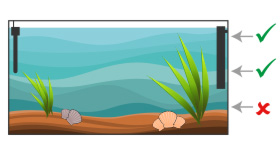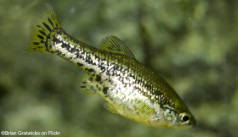

Alternative species (click on the thumbnail to see the card)
Names
Scientific name
Xenotoca eiseni
Xenotoca variata
Characodon eiseni
Neotoca eiseni
Goodea eiseni
Common name
Redtail splitfin
Orangetail goody
Redear goodeid
San Marcos Redtail Splitfin
Eisens-Kärpfling (DE)
Origin

Origin: Central America (Mexico)
Biotope: Non specific
Dimorphism

The male has a nice iridescent blue/green coloration and is slightly smaller than the female. The female is stockier and duller than the male (she is usually brownish/yellowish)
Group

Goodeidae
Volume

120 L / 26 Imp gal / 32 US gal
Parameters

T°: 18 to 28°C or 64 to 82°F
pH: 6.8 to 7.8
Hardness: 10 to 25°dGH
Difficulty

Easy
Size

Male: 5-7cm (2-2.8") / Female: 6-8cm (2.4-3.2")
Longevity

3 to 5 years
Living zone

Middle
Individuals

10
Food
How to feed the Xenotoca eiseni?
Food
How to feed the Xenotoca eiseni?
Very voracious, this fish seems elusive! It needs a varied and abundant diet. Vary the menus to avoid deficiencies in this omnivorous species with carnivorous tendencies. Of course, its preference will naturally go towards live prey! You can give (non-exhaustive list):
artémias
vase worms
daphnia
cyclops
embedded
mosquito larvae
shrimp, mussels and finely ground fish
commercial food (as a supplement)
mashed peas
boiled lettuce
algae
spirulina
vegetable enriched flakes
The contribution of plants is imperative to prevent fish from attacking the young tender thumbs of plants. Plant food will be served at least twice a week. Avoid spinach which could encourage calcium accumulation in the kidneys.
Behavior
What kind of behavior does the Xenotoca eiseni have?
Behavior
What kind of behavior does the Xenotoca eiseni have?
It is a lively and territorial fish but also quite playful: it will put some animation in your aquarium! If it is kept in a too small volume, it becomes aggressive as it goes along.
Like many viviparous, the males get along quite well with each other but constantly chase the females in order to reproduce. Several females are therefore needed for each male to prevent the males from exhausting the females.
Cohabitation
Who can live with the Xenotoca eiseni?
Cohabitation
Who can live with the Xenotoca eiseni?
First of all, they will have to be associated with several of their congeners. Indeed, this gregarious fish imperatively needs the presence of its fellow creatures to flourish. Thus, a group of at least 10 specimens is the minimum to be considered for a correct maintenance. This group will be formed of 2 males and 8 females (see "behavior").
To harmoniously associate Xenotoca with other species, choose robust or bigger fish, with a strong character that Xenotoca will respect. Avoid shy, slow or too calm fish (like Corydoras for example).
Cohabitation with species with large sails is to be avoided because many cases of aggressiveness (biting of the fins) towards them have been reported. It is therefore not advisable to choose roommates such as Guppies, Angelfish, Siamese fighting fish or Gouramis.
Breeding
How to breed the Xenotoca eiseni?
Breeding
How to breed the Xenotoca eiseni?
This species is truly viviparous. Indeed, when the female is pregnant, she produces a placenta and an umbilical cord allowing gas and nutritive exchanges with her fry (there is no emission of eggs). Moreover, the umbilical cord is sometimes still visible in the hours following the birth of the fry.
The breeding of Xenotoca is very easy because it does not require the intervention of the aquarist. It occurs spontaneously when males and females are brought together. The ideal water parameters to trigger reproduction are a temperature of 25°C (77°F) and a pH of 7.
After spawning, incubation lasts 6 to 8 weeks. Each female can give birth to 15 to 20 pups in each litter (sometimes up to 50 for larger females), which occurs every 2 months. At birth, the young fish are perfectly formed and autonomous. They measure between 8 and 12 mm (0.4 to 0.5") and grow rapidly. Sexing is possible after 2 months.
In a well planted aquarium, the fry will be able to escape very easily from the predation of their parents which remains very limited if they are well fed. You can therefore leave them together in the main aquarium. Often, the fry will take refuge near the surface, among the floating plants.
Food for the fry: artemia or cyclops nauplia, microwaves and commercially available surfine powder. The presence of algae is also necessary for the good growth of the fry.
Its aquarium
Which aquarium for the Xenotoca eiseni?
Its aquarium
Which aquarium for the Xenotoca eiseni?
Plan an aquarium of at least 120 L / 26 Imp Gal / 32 US Gal for Xenotoca because they swim quite fast. They therefore need space. Vegetation is necessary for the well-being of the species: create a fairly planted tank but leave space for swimming, plant especially on the sides and the back of your tank, without forgetting the floating plants! Concerning the choice of plants, as this fish is not reluctant to nibble a few shoots, choose rather species with hard and rather robust leaves. For example, take Echinodorus, Vallisneries or Sagittaria lancifolia.
This fish being quite polluting (it eats a lot!), renew the water every week up to 30% of the total volume. For the same reason, it is also necessary to install a filtration system powerful enough to guarantee a constantly clean water (at least 2 to 3 times the volume of the tank per hour). To obtain water that is hard enough, do not hesitate to add sea salt or coarse salt (untreated) and carry out hardness tests until the target GH is found. Generally, the recommended ratio is 1 tablespoon per 10 L / 2 Imp Gal / 3 US Gal of water.
Xenotoca needs some variation in water temperature throughout the year. To simulate these seasons, keep the aquarium around 22°C or 72°F for several months, then gradually increase to 26-27°C or 79-81°F. Leave this for a few months and then gradually decrease again and so on. These variations have a real impact on the health of these fish.
Cover your aquarium because Xenotoca can jump out of the water perfectly.
In summer, you can install your fish in an outdoor pond. This allows a beautiful growth of the young fish and stimulates the reproduction of the adults. Be careful, however, that the water temperature does not drop below 16°C or 61°F.
Good To know
Find all additional information!
Good To know
Find all additional information!
This very robust fish sometimes lives in the wild in very polluted places. It is therefore not afraid of small maintenance gaps in aquariums! It is thus a perfect candidate for the one who starts in aquarium keeping.
Its name "eiseni" was given to it in homage to the geologist and geographer Gustav Eisen, who was a member of the expeditions of the California Academy of Sciences.
Yours photos!
Comments
Sort by:
Please login to post comments


